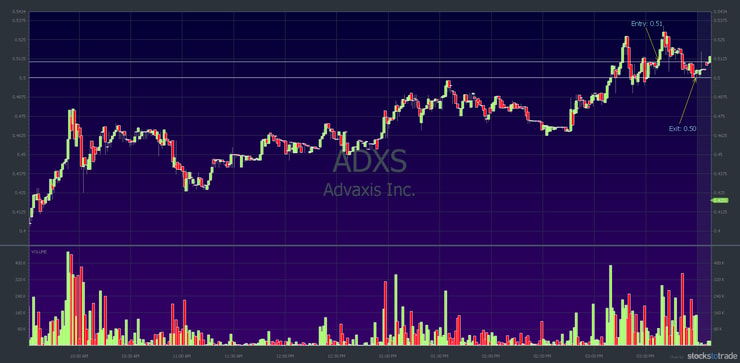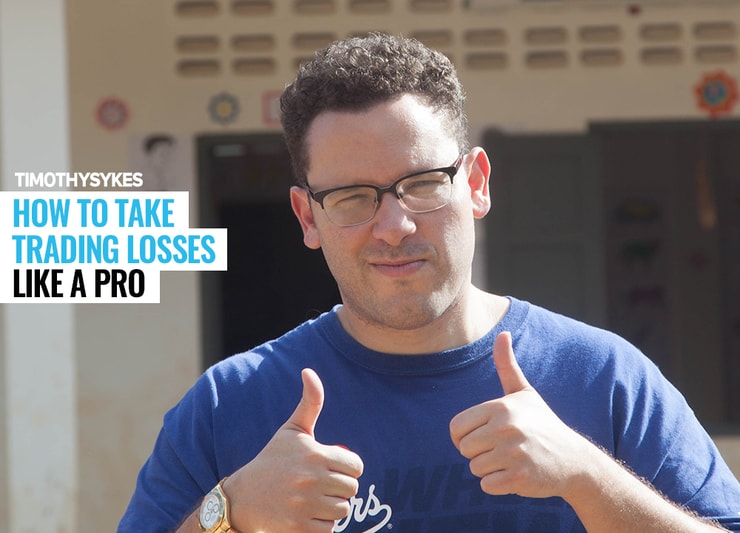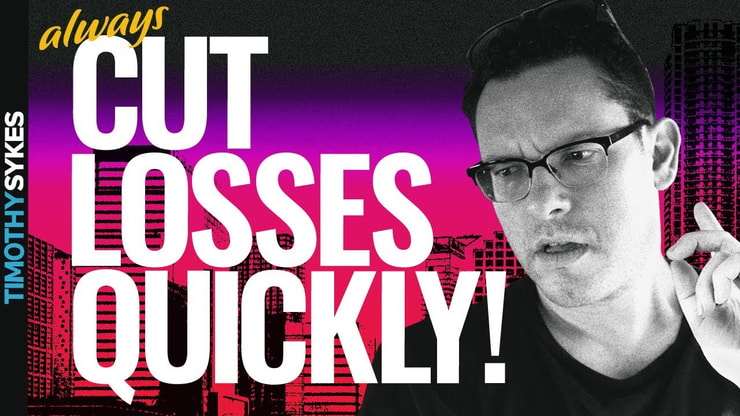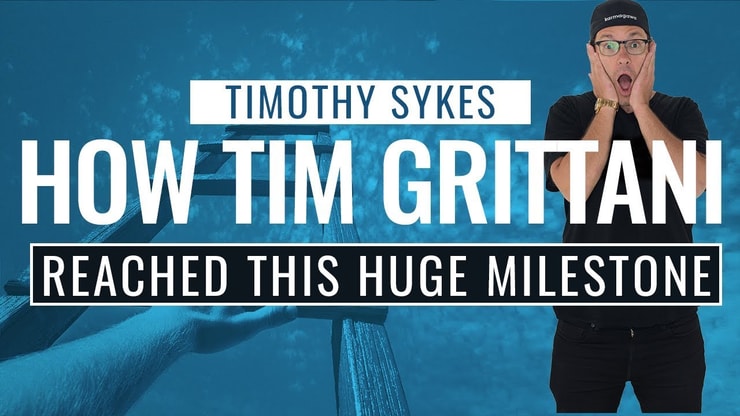So you want to know how to take trading losses like a pro…
Over the past three weeks, my winning percentage is roughly 13% lower than my average. I’ve logged back-to-back losses. And I even had my biggest loss of the year.
Shortly after the back-to-back losses, I got this outpouring of support and sympathy. And I really appreciate that.
But you’ve gotta understand … I’ve been trading for over 20 years and teaching for over 10. If I let a few losses take me down, I wouldn’t be here today. So in my book, those losses were great trades.
Even with my big loss, I’m not unhappy with my entry. And had I not experienced order execution problems (all recorded live during my Trading Challenge webinar on November 29), I would have cut losses much faster. Apply for the Trading Challenge here.
I’m working on a post about my biggest loss — coming soon — but for now, I want to focus on the back-to-back losses from November 14 and 18 because there are solid lessons in those two trades.
So how can you lose money and call it anything but a bad trade? Simple, follow your plan. That’s exactly what I did. And I stuck to rule #1 and cut losses quickly.
Table of Contents
Rule #1: Cut Losses Quickly
Rule #1 is to cut losses quickly. We’re all here to make money … But first, you have to understand how to manage your losses. It’s the first rule because it’s the most important and also the hardest for my students to follow.
There are five possible ways a trade can end:
- A big win
- A small win
- Breakeven (scratch)
- A small loss
- A big loss
The greatest threat to your ability to continue trading is a big loss. A big loss can completely disrupt your mental process. And a big loss can cause you to lose your most important trading tool: your money.
In a game where 90% of people lose, you have to do something different. Learn to eliminate big losses to head in the right direction.
Also, remember that there will always be another trade. No one trade will ever make you rich. But one trade can blow up your account. If you use leverage or short sell, you can actually lose more than your entire account and go into debt.
Learn rule #1. It’s #1 for a reason … Cut those losses quickly.
How to Stay in the Game

2025 Millionaire Media, LLCWhen you’re learning to trade, your top priority is to not go broke. So many traders get into trading only to blow up their accounts within a year or two. With all the newbie traders and wannabe shorts out there, some blow-up even faster.
Don’t be like those traders. You have to learn to never — under any circumstances — take a big loss. How do you avoid big losses? By taking smaller ones. You have to get out of bad trades quickly.
My last trade before ADXS was ASTC (get all the details in this post). I lost roughly $150 on each of these trades. ASTC eventually spiked just as I predicted … just not at the time I expected. Did I hold and hope? No way. I got out.
Am I sad about the loss? Not at all. What you have to understand is…
… I trade with a small account to show you the process. And…
… any money I make from trading goes to charity. Why? Because I want my students — and I count you as a student if you read the blog every day — to see my priority is teaching.
So I gladly lose $150. Heck, the cost of sending out text messages and emails to my students when I alert them is higher than that. And I gladly pay it because the lessons are far more valuable for you.
So I don’t judge trades based on the resulting profit or loss. I judge my trades based on whether I stuck to my process and trade plan. This is one of the hardest lessons I teach — and one of the most important for you to learn.
Remember the big picture. Learn to trade smart.
Lessons From Advaxis Inc. (NASDAQ: ADXS)
Here’s my comment from when I entered the ADXS trade on November 18:
I bought this speculative runner that’s closing near day highs on a strong first green day with breakout volume…goal is to make 7-15% selling afterhours … if I can sell .55-.60 I’ll take it, cut losses quickly if wrong, same rules as always to protect myself…
When it was clear the trade wasn’t going my way, I got out. I don’t like choppy stocks and I don’t chase.
Take a look at the ADXS chart:

Here’s what I said as I got out of of the trade:
Not closing strong at all, small losses are fine, onto the next, potential rebuy if it can break .53 day highs tomorrow morning too for possible followup spike but this one is choppy.
I bought this one because I thought it would close strong. Shortly after I got in, the buying slowed down. I sold quickly and took a small loss.
I always have a specific thesis about a stock. If the stock doesn’t do what I want — when I want — I get out. This one went up, just like I predicted. But again, the timing wasn’t what I expected.
Learn to trade like a retired trader. Only come out of retirement for the very best plays. If one of those trades doesn’t pan out exactly as you predicted, get out and preserve your money.
Remember to Focus on Process Before Profits
I’m very blessed to be able to focus on the process. Most people have to make profitable trades just to pay the bills. Or to keep disapproving friends and family at bay. But what you have to understand is that the money you make or lose in the beginning — the first 9, 12, or even 18 months…
… is negligible compared to the upside 24 or 48 months down the road if you focus on the process.
You must have a trading plan for every trade you make — and that has to include an exit. A lot of ‘gurus’ and other traders love to focus on profits. But you also gotta know your point of maximum pain.
So if the trade doesn’t go as you thought, where will you get out, accept your loss, and live to fight another day?
Remember: this is a marathon, not a sprint. Prepare for the long run. Some of the most successful traders I know lose 60% or even 70% of the time. These traders make huge profits on their wins and keep their losses small. It’s all about managing risk/reward.
Losses are part of every successful trader’s process. Learn how to take trading losses like a pro.
Is it easy? Nope. A lot of traders never learn this lesson. It’s the primary reason 90% of people fail at trading. If you have what it takes to manage your losses, you might have what it takes to be one of my students. Apply for my Trading Challenge now.
How Professional Traders Focus on the Process
No one’s perfect, not even the professionals at the top of their game. Here’s what the pros do: they treat trading like any other business. And businesses come with ups and downs, expenses and income, wins and losses.
Trading is no different. Think of losses as an expense that all traders pay. No trader has a perfect record. We all lose sometimes. But you can learn to keep your losses small.
My six-figure student Kyle Williams gets it. He knows trading is about way more than just profits or losses. His best trade wasn’t even his biggest win.
More Breaking News
- SoundHound AI: Financial Controls Under Scrutiny
- Why Concentrix Stock Skyrocketed?
- Luminar Technologies Makes Big Strides: Time to Invest?
How Tim Grittani Cuts Trading Losses
My top student of all time now has more than $8.5 million in profits.**
Ask Grittani, and he’ll tell you that his most important trades are his losses. Why? Because he learns from them.
Yes, we all want to make money from our trades, but understand that losses are part of every trader’s reality. Even the best traders in the world have to cope with losses.
Grittani approaches trading a little differently than I do. He “cuts losses intelligently,” which is a little different than my method of “cutting losses quickly.” The key takeaway is still that he cuts his losses. Learn from Grittani’s losses — don’t let them get too big.
All great traders who have long-term trading success have a plan to get out of their trades when they go against them. As a new trader, you need to stick you your plan and cut your losses quickly. So if you wanna try Grittani’s method, that’s great. But get consistent first — don’t just try it if you’re completely new to trading.
Also remember that Grittani didn’t make anything for his first nine months of trading. So if arguably the best penny stock trader in the world took nine months to become consistent, it will probably take you longer. And that’s OK.
(If you’re new to penny stocks or need a refresher, check out my FREE penny stock guide here.)
How to Avoid Big Losses

2025 Millionaire Media, LLCI want to share a few tools that can help you develop your loss-cutting abilities. This is the most important skill you will ever learn in trading. Given that trading is highly personal and everyone must develop their own style, these are just a starting point.
Get Out Quickly
When you enter a trade, you should have a trading plan based on your thesis. You want to be clear about what you think will happen. But don’t expect it to happen. Instead, react to the price action. If something doesn’t look right … get out! If it breaks through a support level or fails to hold a breakout above resistance … get out!
Do what I did with ADXS and ASTC. If the price stalls or volume dries up, exit the trade. If you’re in the red when you expected to be in the green … don’t wait, get out. Don’t ever hold and hope.
Here’s the thing, sometimes you’ll exit a trade and then the stock does exactly what you predicted. It happens. Learn from this. Study the chart and see if you can change your process for the next trade. Don’t search for a reason to stay in. Sometimes you have to take a small loss and move on to the next.
Changing your process is OK. Just don’t do it in the middle of a trade. Stick to the original plan you made before entering the trade. The trade thesis you came up with before you put any money on the line is usually the best one. Only change your process after you exit the trade and evaluate what happened.
When Should You Use Stop-Loss Orders?
Full disclosure: I don’t use stop-loss orders. I use mental stops.
I’ve been doing this for over 20 years and am successful in using mental stops. But as a teacher, I’ve learned that so many people struggle with sticking to their plan once they’re in a trade.
If you struggle to stick to your plan, automatic stop-loss orders can be a way to make you stick to your plan. You can enter a stop-loss order as soon as you get into the trade. Some brokerages allow for an automatic stop as soon as your original order is executed.
Keep in mind automatic stop-loss orders don’t guarantee an execution price. This is a training tool for you to use while you get used to the idea of cutting losses quickly. Penny stocks move very fast. So your execution price can be far from your stop price. Keep position sizes small to limit your risk.
While it’s not my preferred tool, you can use it to help you find what works for you to minimize your losses.
You Lost … What Now?
After you take a loss, you might feel bad. Many of you sent me messages after my two losses and tried to encourage me.
I’m grateful for the support, but I’m not upset at all. I’ve been doing this for over 20 years. Every year, I’ve been profitable. And every year I’ve taken losses. I understand the process.
Your job is to learn from me … Learn from my wins and from my losses. Understand it’s all part of the process. And as long as you trade, you will take losses. The key is to keep them small.
It’s OK to feel bad after a loss. It’s normal. But over time, you can learn to deal with them. But know that they can mess with your mindset…
Don’t risk additional money if you’re hung up on a loss. NEVER try to break even.
Too many new traders judge a trade based on the outcome. So, a ‘good trade’ is a profit and ‘bad trade’ is a loss. Not true. Get this out of your head. A good trade is when you stick to your plan and follow the rules, like rule #1, cut losses quickly.
If you’re dwelling on a loss, you need to take a break. Close your laptop and walk away. Do anything but get in another trade. The market will always be there. There will always be another trade. Trust me — you won’t miss anything. But you can save yourself from another loss.
“The Complete Penny Stock Course” has excellent information about how to take trading losses like a pro. See the personal requirements section on page 45. Also read Chapter 1.5 — The Psychology of the Penny Stock Trader (page 51).
Recent Comments and Trades From Students

2025 Millionaire Media, LLCHere are some comments from students who cut losses quickly, preserved their cash, and lived to fight another day.
On SSI, migtrader cut losses quickly:
11/22 4:04 PM migtrader: Didn’t breakout of 4.85, big reversal exited fast.
GHSI didn’t go as planned for some traders, but Maui2020 got out fast:
11/23 4:33 PM Maui2020: Bought 10,000 GHSI @ 0.25 at 10:11 AM ET on a pullback from the breakout above 0.25 Exit Comments: Sold 10,000 GHSI @ 0.245 @ 10:19 AM ET when it failed to continue to run above 0.25 Loss of $50 or 0.05 or 2% Lesson: On the right track but resistance breakout is above 0.27
And some traders learn NOT to chase, like xnoobiex:
11/23 4:33 PM xnoobiex: A test trade. I do think this have potiential to keep going up but it’s too choppy for me. Cut loss.
For @TessaLamping, it’s a life lesson …
Ever since I found Tim Sykes on youtube, this lesson has probably been the lesson I use most in life. Rule #1 cut losses quickly has given me more confidence in and out of trading ♡ thank you! https://t.co/5W2pzHhZR0
— Tessa (@TessaLamping) October 28, 2019
@Jackaroo_ Trades is one of my top students because he cuts his losses quickly. He works to keep losses small and allows his wins to add up.
Cut losses quickly or intelligently?
For me, it’s all about cutting quick. I always have an idea of where I want to risk, but if I don’t like the price action.. I get out. You can always reenter.
Very consistent last couple months 🙏. No huge wins, but singles keep adding up! pic.twitter.com/Mxm5CMqZYa
— Jack Kellogg (@Jackaroo_Trades) November 15, 2019
These students show their ability to follow rule #1. When a trade goes against you, get out. The only way to find consistency and stay in the market is to cut your losses quickly.
You gotta learn how to take your trading losses like a pro. If you can learn to eliminate big losses, you just might have a shot at a long-term trading career.
Ready to take your trading to the next level? See if you have what it takes to be one of my challenge students. Apply for my Trading Challenge now! (Lazy traders need not apply.)
[**Note that these results aren’t typical. These students put in the time and dedication and have exceptional skills and knowledge. Most traders lose money. Always remember trading is risky … never risk more than you can afford.]
What do you think of this post? Share your thoughts in the comments below!















Leave a reply